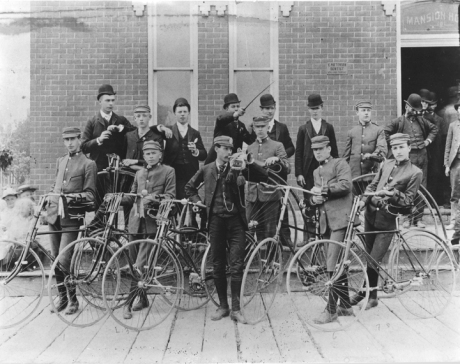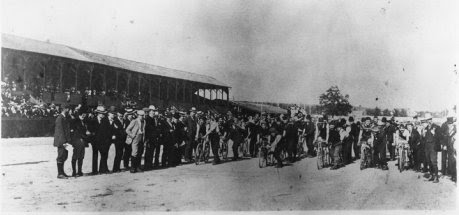The Royal Canadian Bicycle Club
The Royal Canadian Bicycle Club
Early Sport in Riverdale
by Gerald Whyte
The Royal Canadian Bicycle Club, established in 1891, had its origins in the Royal Canadian Athletic Club, an association of some 100 young men last located at 740 Queen Street East in Toronto. When the new club was formed only five of its members had bicycles and these were the hard tire variety. The first officers of the small club were: David Smith, President, S.H. Gibbons, Captain, E. McTeer, First Lieutenant and Fred Creed, Second Lieutenant. The first home of the club was in the Smith Block at 651 Queen Street East.

Opening of cycling season May 23, 1891, A.E. Walton with the bugle
In the spring of 1892 the club moved to the (Alan Hoover) Dingman Block at 736 Queen Street East where new officers were selected: D. Smith, President, S.H. Gibbons, Vice-President and James Murray, Secretary-Treasurer. in the fall the Club moved to larger quarters in (Archibald) Dingman Hall at 112 Broadview Avenue. Money was a problem for the new club until A.E. Walton, a local entrepreneur and organizer, provided the needed financial management from 1893 - 1896 when he was President. He was to play a major role in Club activities fro 50 years. In the fall of 1903 the Club won its first victory in a team competition at the Cahadian National Exhibition eventually winning a world championship race in 1896.
Cycling in Riverdale received a boost from two dvelopments. The first was external with the invention of the pneumatic tire by John Dunlop in 1888. This allowed a much smoother ride. The second occurred in 1884 when the area of Riverdale north of Queen Street was annexed by the city, allowing for great improvement in local roads. This also allowed a much smoother ride.

The start of the 20 mile Dunlop Trophy Race in 1898
The Dunlop Tire company, as a major supplier of bicycle tires, promoted bicycle racing, an exciting sport, which led to increased bicycle sales. They sponsored their first race at the Woodbine Racetrack in 1894 when the Royal Canadian Bicycle Club competed against four other top club teams. The 20 mile race ended in a dispute which resulted in the Atheneum Club taking the trophy. However the next year the Royal Canadians returned, this time to win. When they won a second straight in 1896 they were allowed to keep the coveted Dunlop Trophy. It is one of the largest trophies in existence, made of ebony and silver and standing seven feet tall! It was valued at $1,000 at the time. The Dunlop Trophy remains to this day at the Royal Canadian Curling Club, the successor club of the bicycle club.
The "east end heroes of the wheel" who won the Dunlop Trophy were: L. Bounsall, C. Leamen, P. Humphreys, H. Parkins, H. Thompson, A. Oake, G. Nicholson, G. Capps, W. Simpson and J. Anderson.

The winning team for the 1899 Dunlop Trophy Race
By 1897 the Royal Canadian Bicycle Club was well established. Their premises in Dingman's Hall are described in the Toronto Evening Star: "The club parlours are upholstered and furnished in the best of style and the pictures of the winning teams decorate the walls. A padded boxing room, a pool room, a card room, a smoking room, a reading room and a first class gymnasium are amoing the attractions."
In 1907 the Royal Canadian Bicycle Club moved into their new clubhouse at 131 Broadview Avenue, J. Francis Brown, architect. in 1929 the name was changed to the Royal Canadian Bicycle and Curling Club when the ice arena was built behind the clubhouse, H.S. Salisbury, architect.
The above is reprinted with the kind permission of Gerald Whyte and the Riverdale Historical Society.




